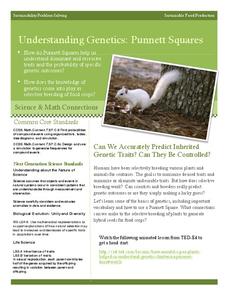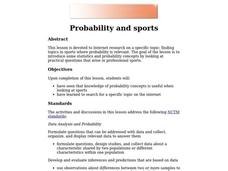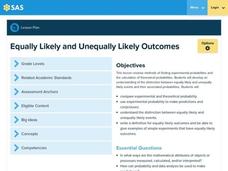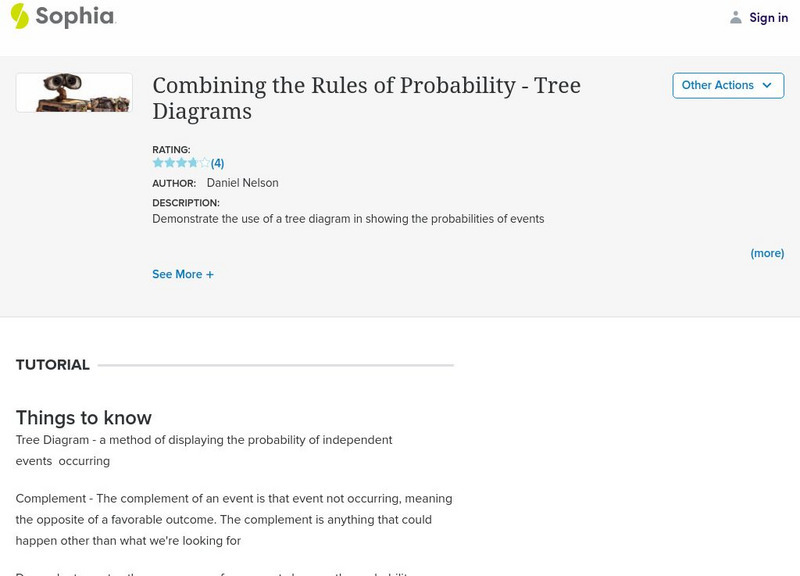Curated OER
Figure This! Math Challenges for Families
Young mathematicians complete a family math challenge packet. They will complete a packet of mixed math activities. They work with graphs, comparing numerical data, tessellations, and probability.
Achieve
False Positives
The test may say you have cancer, but sometimes the test is wrong. The provided task asks learners to analyze cancer statistics for a fictitious town. Given the rate of false positives, they interpret the meaning of this value in the...
Curated OER
New York State Math Test Grade 5
In this New York State math test worksheet, 5th graders complete multiple choice questions on place value, angles, fractions and more. Students complete 26 problems.
Houghton Mifflin Harcourt
Unit 8 Math Vocabulary Cards (Grade 4)
Enhance fourth graders' math vocabulary with 17 word cards and their definitions. Learners focus on terms that deal with graphing, such as y-axis, coordinates, plot, and ordered pair in the last set of math vocabulary cards.
Western Kentucky University
Understanding Genetics: Punnett Squares
Can scientists really predict genetic outcomes or are they simply making a lucky guess? Scholars first learn about Gregor Mendel and how to make Punnett squares. Then they extract DNA from a strawberry in a lab with included conclusion...
Curated OER
Probability: The Study of Chance
Students conduct an experiment, determine if a game is fair, and collect data. They interpret data, then display line graph. They conduct analysis of game for probability.
Curated OER
Basic Counting Principle
Students find the number of possible arrangements of several objects by using the Basic Counting Principle. In this math lesson, students divide into groups and determine the number of possible sandwiches which can be made given certain...
Curated OER
Probability and Expected Value
Students collect data and analyze it. In this statistics lesson, students make predictions using different outcomes of trials.
National Council of Teachers of Mathematics
Is It Fair?
In this probability instructional activity, learners answer nine questions about the fairness of games. High schoolers determine if a game is fair or not. They list outcomes and find ones' chances of winning.
Curated OER
The Fair Factor
Young scholars participate in playing many games to determine if they are fair or not. They create their own game that is fair to play with their classmates.
Curated OER
Probability
Sixth graders explore theoretical and experimental probability. In this probability lesson, 6th graders participate in several hands-on activities involving the comparison of theoretical probability to the actual results. Games include...
Curated OER
Probability: The Study of Chance
Students practice the basic principles of probability by conducting an experiment, determining if a game is fair, collecting data, interpreting data, displaying data, conducting analysis, and stating and applying the rule for probability.
Curated OER
Probability and Sports
Students research topics on the internet where probability is relevant. Students study statistics and probability concepts by looking at practical questions that arise in professional sports.
Curated OER
Loyalists
Students explain why some colonists remained loyal to England during the American revolution. In this social studies lesson, students write a letter to an editor about their reasons for remaining loyal to England.
Pennsylvania Department of Education
Equally Likely and Unequally Likely Outcomes
Students explore probability. In this statistics/probability lesson, students compare experimental and theoretical probability and use experimental probability to make predictions and conjectures. Students explore the...
Curated OER
Probability: the Study of Chance
Students experiment to determine if a game is fair, collect data, interpret data, display data, and state and apply the rule for probability. Students use a simple game for this experiment.
Curated OER
Time-Axis Fallacy and Bayes Theorem
Students determine that knowledge of an event's outcome can affect the probability of the unknown outcome of an event that has already occurred.
Curated OER
Matching Pairs
Pupils examine the probability of the various findings in a game and determine the odds of winning. They differentiate between the facts of odds versus probability. Students use higher order thinking skills to explain how a problem is...
Curated OER
Chapter 11 What's Your Preference
In this math worksheet, students record the results of a survey taken from family members about relationships and activities.
Curated OER
Compound Locus
Students investigate circles and compound locus. In this geometry lesson, students identify the distance from a point to a line. They use Cabri software to create lines and circles.
Sophia Learning
Sophia: Combining the Rules of Probability Tree Diagrams
Tree diagrams are the focus of this learning tutorial. The lesson includes important vocabulary along with two videos and PowerPoint presentations that demonstrate how to create tree diagrams with both independent and dependent events.
Other
Siyavula: Textbooks: Mathematics Grade 11: Probability: Tree Diagrams
Learn what a tree diagram is and how to solve a word problem while using one. View the solution steps and examples for three different problems. Then practice by solving four word problems on your own and checking the answers to see how...
Sophia Learning
Sophia: Compound Event
The term compound event is defined and the video lesson provides several examples including a tree diagram.
Annenberg Foundation
Annenberg Learner: Analyzing Binomial Probabilities
A tree diagram is a helpful tool for determining theoretical or mathematical probabilities. Toss a coin and watch as branches represent a toss of either head or tails.






















